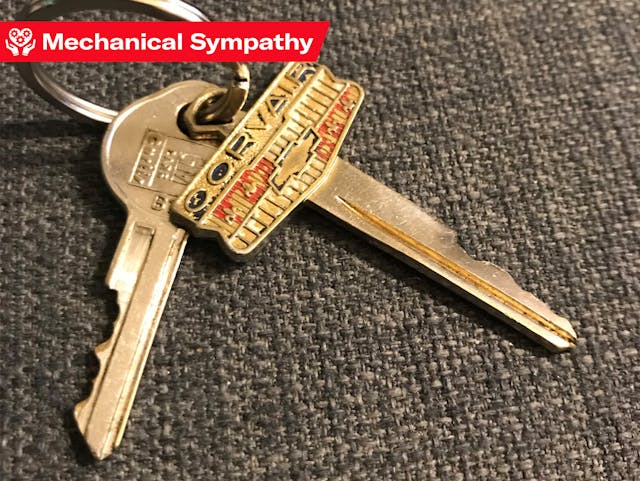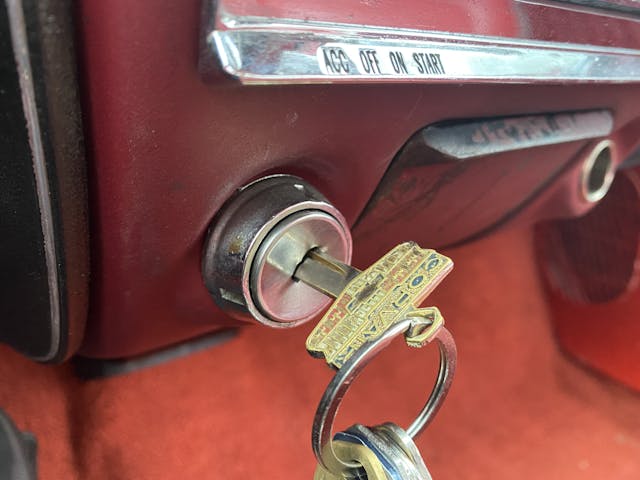Media | Articles
A tolerance for gorillas

Hey there. I’m Kyle. My presence on these digital pages is not new, but this column is. Beginning this week, Mechanical Sympathy will explore the ways we interact with machines, both in upkeep and use, and how those stir the soul. Read my introduction to the column here.
A soft touch can be incredibly powerful. Now that you are thinking about that, let me reel you back. This is a family-friendly automotive website and you thought that was where I was going? Shame on you.
No, this is about the key to my 1965 Chevrolet Corvair, and how it became the test for how much respect and space you are going to get when you drive it. My beloved coupe is nothing special. The data plate shows no rare options, the rear quarter-panels have some rust, and the interior is nice but not so much that you’d hesitate to hop in with wet shoes after a nice fall drive. This car is the picture of a “driver” that is meant to be enjoyed.
Keeping ropes around a car is an excellent way to make sure no one cares about it. That’s why I hold myself to a rule that came from someone I’ve never met. While at an event, sometime around 2011, I overheard one person yell, “If you can start it, you can drive it!” to someone peeking in the window of a cherry red Pontiac. This same offer had been a joke with a few of my college friends when I built up a Honda XR650R motard, which required a very particular song and dance to fire up. Not a lot of people got to ride that bike, but there was no shortage of tired legs from kicking it over.
This Corvair starts a whole lot easier than that motorcycle did. Wherever it goes, which is a lot of places, I will toss the keys to anyone who shows interest in driving it. After they slide behind the seat and get a quick rundown of the controls comes the test: Do they know how to turn a key?
Marketplace
Buy and sell classics with confidence
It’s so simple. And yet my Corvair key is mangled and bent three different ways.
To be fair, most cars have not used turn keys in years. Even if one does, the system doesn’t require the operator to hold the switch to keep the engine cranking. A flick of the key, and the engine will crank until it starts, at which point the computer takes over, because it knows better. This digital intervention used to annoy me greatly, but after hearing my Corvair starter grind after the engine caught, and after clamping the key in a vise to straighten it for the third time, I am reminded that modern cars are built to preserve themselves from the lowest common denominator. This approach insulates the curious from learning how the machine works because it just works. If you do something wrong, which you really can’t on a modern car, there is no auditory or haptic feedback. You can ham-fist the starting procedure for years and never know it.
Maybe part of the problem is that my car’s key is quite ornate. The head bears a nice Corvair script inset with decorative colors that have aged to a delightful patina. That detailing means the head is wide and give users an unexpected amount of leverage compared to the rounded plastic fob of any key from the last 25 years. Between robust, anti-theft lock cylinders and the smooth keys, it is almost difficult to put too much torque into a modern ignition. Most likely, people don’t realize the force they are putting on an old system—most people haven’t even unlocked a car door with a key for years.
These bad habits set in because drivers literally did not know better and no one said anything to them. Then they get the chance to drive my Corvair and the first bit of feedback is pursed lips and a through-the-nose exhale as the start grinds and the key bends. As much as the mechanical abuse hurts my soul—and the car—it is a necessary evil. Watching how these drivers start the Corvair tells me how the drive will go, and how much coaching I will be doing from the right seat. If you He-Man twist that delicate little key, you will hear the script that is burned into my brain about how a clutch works, followed by a reminder that old brakes are old brakes and you need to treat them as such. A bent key may be an easy repair, but I’m not going to let ignorance cost me a clutch.
Yet I continue to offer this key to strangers. I have to. We have to. Each of us had to start (see what I did there?) somewhere on the journey of learning how mechanical things work. It takes a tender touch to keep the key from twisting off in the dashboard’s cylinder these days, reminding me that the Corvair, like any other machine, is a living thing. It will only last as long as someone takes care of it and wants it around.
Check out the Hagerty Media homepage so you don’t miss a single story, or better yet, bookmark it.







It’s also fun watching people trying to figure out how the seat belts work
When I was 12 years old, our dealership took in an early “60’s Corvair that had an ignition switch that would turn without a key if not returned to the lock position. I jumped in it one afternoon and taught myself how to drive stick. What a blast!!
Does anyone remember the 1955/56 Buicks where you had to push the gas pedal to start the car? Man I’m I getting old. Hey Kyle is a 65 Corvair convertible with Corsa engine worth anything? Not a Corsa but a Monza with a transplant I believe. It runs, all the carbs have been replaced. Doesn’t look too bad but has some rust.
Hey Robert: I recall a few trucks that had the starter switch under the gas pedal, but it’s been awhile since I’ve crossed paths with one. As for your Corvair question, the Corsa did not have a unique engine so while the engine may be swapped it also may not be. The 140hp four-carb engine was an option on Monza trim levels as well. That said, it absolutely has value. You can look for a Corvair club in your area (CORSA is the national club that might have a listing for a local chapter near you) and there is likely a buyer or knowledgable person who would be happy to help you in listing or knowing what you have.